英文科研论文写作技巧
- 格式:doc
- 大小:260.50 KB
- 文档页数:24
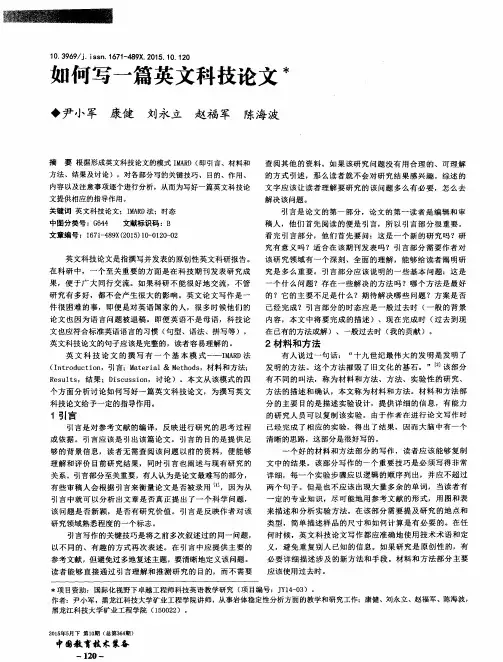
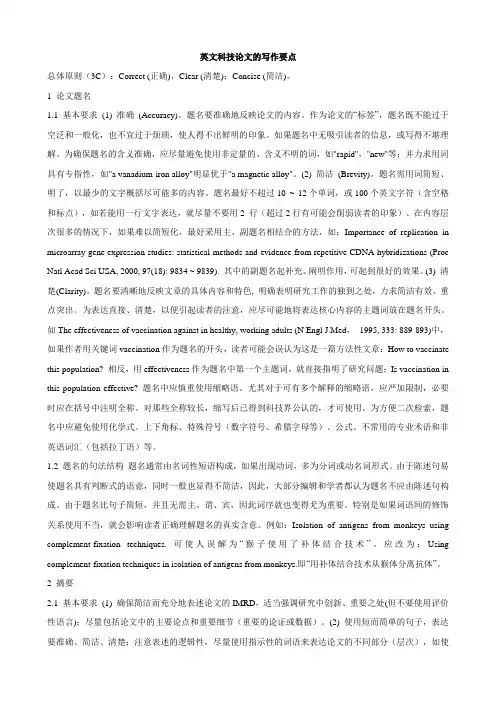
英文科技论文的写作要点总体原则(3C):Correct (正确),Clear (清楚);Concise (简洁)。
1 论文题名1.1 基本要求(1) 准确(Accuracy)。
题名要准确地反映论文的内容。
作为论文的“标签”,题名既不能过于空泛和一般化,也不宜过于烦琐,使人得不出鲜明的印象。
如果题名中无吸引读者的信息,或写得不堪理解。
为确保题名的含义准确,应尽量避免使用非定量的、含义不明的词,如"rapid","new"等;并力求用词具有专指性,如"a vanadium-iron alloy"明显优于"a magnetic alloy"。
(2) 简洁(Brevity)。
题名需用词简短、明了,以最少的文字概括尽可能多的内容。
题名最好不超过10 ~ 12个单词,或100个英文字符(含空格和标点),如若能用一行文字表达,就尽量不要用2 行(超过2行有可能会削弱读者的印象)。
在内容层次很多的情况下,如果难以简短化,最好采用主、副题名相结合的方法,如:Importance of replication in microarray gene expression studies: statistical methods and evidence from repetitive CDNA hybridizations (Proc Natl Acad Sci USA, 2000, 97(18): 9834 ~ 9839). 其中的副题名起补充、阐明作用,可起到很好的效果。
(3) 清楚(Clarity)。
题名要清晰地反映文章的具体内容和特色, 明确表明研究工作的独到之处,力求简洁有效、重点突出。
为表达直接、清楚,以便引起读者的注意,应尽可能地将表达核心内容的主题词放在题名开头。
如The effectiveness of vaccination against in healthy, working adults (N Engl J Med,1995, 333: 889-893)中,如果作者用关键词vaccination作为题名的开头,读者可能会误认为这是一篇方法性文章:How to vaccinate this population? 相反,用effectiveness作为题名中第一个主题词,就直接指明了研究问题:Is vaccination in this population effective? 题名中应慎重使用缩略语。
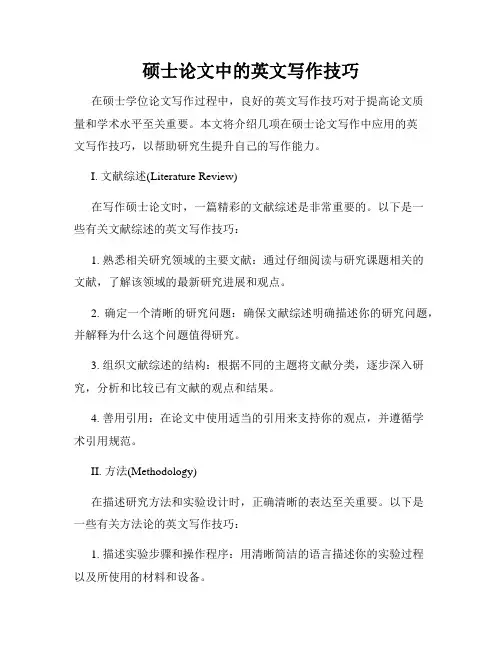
硕士论文中的英文写作技巧在硕士学位论文写作过程中,良好的英文写作技巧对于提高论文质量和学术水平至关重要。
本文将介绍几项在硕士论文写作中应用的英文写作技巧,以帮助研究生提升自己的写作能力。
I. 文献综述(Literature Review)在写作硕士论文时,一篇精彩的文献综述是非常重要的。
以下是一些有关文献综述的英文写作技巧:1. 熟悉相关研究领域的主要文献:通过仔细阅读与研究课题相关的文献,了解该领域的最新研究进展和观点。
2. 确定一个清晰的研究问题:确保文献综述明确描述你的研究问题,并解释为什么这个问题值得研究。
3. 组织文献综述的结构:根据不同的主题将文献分类,逐步深入研究,分析和比较已有文献的观点和结果。
4. 善用引用:在论文中使用适当的引用来支持你的观点,并遵循学术引用规范。
II. 方法(Methodology)在描述研究方法和实验设计时,正确清晰的表达至关重要。
以下是一些有关方法论的英文写作技巧:1. 描述实验步骤和操作程序:用清晰简洁的语言描述你的实验过程以及所使用的材料和设备。
2. 确定参与者和样本:详细描述研究涉及的参与者或样本选择过程,包括参与者的特征和招募方式。
3. 数据收集与分析方法:明确指出你使用的数据收集方法,例如问卷调查或实验观察,并简要描述你选择的数据分析方法。
4. 强调研究方法的可靠性和有效性:讨论你所采用的方法的优点和局限,并解释为什么你认为这些方法能够帮助你回答研究问题。
III. 论文结构与段落连贯一个良好的硕士论文应该有清晰的结构和流畅的段落连接。
以下是一些建议:1. 逻辑结构:确保你的论文有明确的引言、文献综述、方法、结果和讨论等部分,并将它们有机地连接在一起,形成一个完整的逻辑结构。
2. 段落结构:每个段落都应该有一个明确的主题句,并围绕这个主题句展开论述。
同时,采用适当的过渡词来使段落之间的连接更加自然。
3. 语言风格:使用简练、准确的语言来阐述观点,避免冗长和复杂的句子结构。
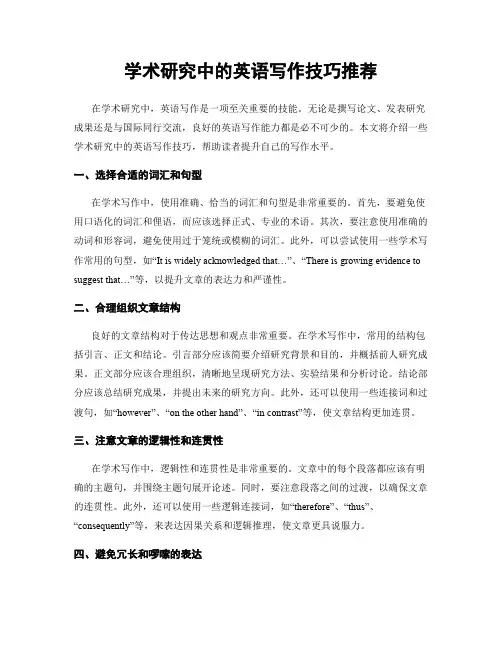
学术研究中的英语写作技巧推荐在学术研究中,英语写作是一项至关重要的技能。
无论是撰写论文、发表研究成果还是与国际同行交流,良好的英语写作能力都是必不可少的。
本文将介绍一些学术研究中的英语写作技巧,帮助读者提升自己的写作水平。
一、选择合适的词汇和句型在学术写作中,使用准确、恰当的词汇和句型是非常重要的。
首先,要避免使用口语化的词汇和俚语,而应该选择正式、专业的术语。
其次,要注意使用准确的动词和形容词,避免使用过于笼统或模糊的词汇。
此外,可以尝试使用一些学术写作常用的句型,如“It is widely acknowledged that…”、“There is growing evidence to suggest that…”等,以提升文章的表达力和严谨性。
二、合理组织文章结构良好的文章结构对于传达思想和观点非常重要。
在学术写作中,常用的结构包括引言、正文和结论。
引言部分应该简要介绍研究背景和目的,并概括前人研究成果。
正文部分应该合理组织,清晰地呈现研究方法、实验结果和分析讨论。
结论部分应该总结研究成果,并提出未来的研究方向。
此外,还可以使用一些连接词和过渡句,如“however”、“on the other hand”、“in contrast”等,使文章结构更加连贯。
三、注意文章的逻辑性和连贯性在学术写作中,逻辑性和连贯性是非常重要的。
文章中的每个段落都应该有明确的主题句,并围绕主题句展开论述。
同时,要注意段落之间的过渡,以确保文章的连贯性。
此外,还可以使用一些逻辑连接词,如“therefore”、“thus”、“consequently”等,来表达因果关系和逻辑推理,使文章更具说服力。
四、避免冗长和啰嗦的表达学术写作应该力求简洁、明了,避免冗长和啰嗦的表达。
可以通过删除冗余的词汇和句子,简化句子结构,以及使用简洁的动词和形容词来实现。
此外,还可以使用一些缩写词和缩略语,如“e.g.”、“i.e.”、“etc.”等,来简化表达。
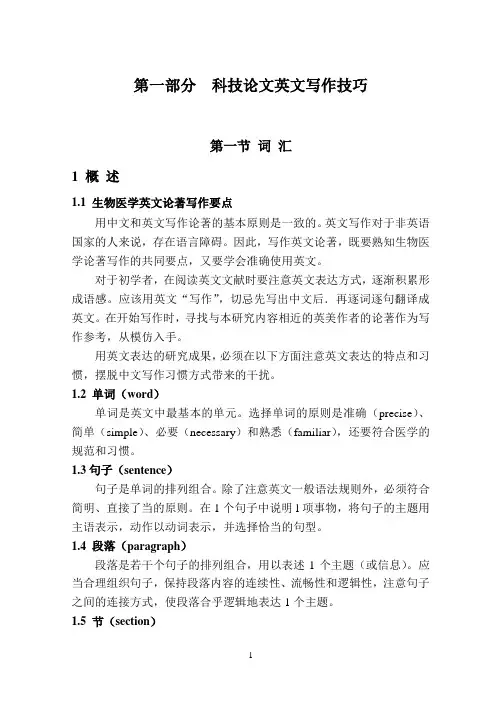
第一部分科技论文英文写作技巧第一节词汇1 概述1.1 生物医学英文论著写作要点用中文和英文写作论著的基本原则是一致的。
英文写作对于非英语国家的人来说,存在语言障碍。
因此,写作英文论著,既要熟知生物医学论著写作的共同要点,又要学会准确使用英文。
对于初学者,在阅读英文文献时要注意英文表达方式,逐渐积累形成语感。
应该用英文“写作”,切忌先写出中文后.再逐词逐句翻译成英文。
在开始写作时,寻找与本研究内容相近的英美作者的论著作为写作参考,从模仿入手。
用英文表达的研究成果,必须在以下方面注意英文表达的特点和习惯,摆脱中文写作习惯方式带来的干扰。
1.2 单词(word)单词是英文中最基本的单元。
选择单词的原则是准确(precise)、简单(simple)、必要(necessary)和熟悉(familiar),还要符合医学的规范和习惯。
1.3句子(sentence)句子是单词的排列组合。
除了注意英文一般语法规则外,必须符合简明、直接了当的原则。
在1个句子中说明l项事物,将句子的主题用主语表示,动作以动词表示,并选择恰当的句型。
1.4 段落(paragraph)段落是若干个句子的排列组合,用以表述1个主题(或信息)。
应当合理组织句子,保持段落内容的连续性、流畅性和逻辑性,注意句子之间的连接方式,使段落合乎逻辑地表达1个主题。
1.5 节(section)按论著格式,若干段落组成节(section),如摘要、引言、材料和方法、结果讨论等。
每一节都要按照相应的要求组织,并围绕论著主题明确表述设想、实施、结果、得到的论点等各个环节,应注意各节之间的关系和连接。
1.6 全文(paper)论著全文除了上述的各节内容外,还有题目、作者姓名、单位、地址、参考文献、致谢等内容。
写完全文后,应当检查各部分内容是否明确、重点地反映了论著的主要论点,检查有无遗漏、错误,并仔细作文字调整和润色。
有条件时,可请英文水平较高的专业人员或外国专家对论著进行审阅和修改。
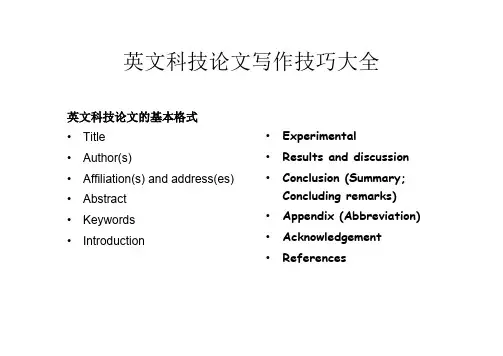
英文科技论文写作技巧大全英文科技论文的基本格式•Title•Author(s)•Affiliation(s) and address(es) •Abstract•Keywords•Introduction •Experimental •Results and discussion •Conclusion (Summary;Concluding remarks) •Appendix (Abbreviation)•Acknowledgement •References2.基本要求(1)Title长短适中,概括性强,重点突出,一目了然。
(2)Author(s)姓氏和名字要容易弄清楚,以免发生以名代姓。
(3)Affiliation(s) and address(es)准确清楚,使读者能按所列信息顺利地与作者联系。
(4)Abstract不宜太详尽,也不宜太简短,应将论文的研究体系、主要方法、重要发现、主要结论等,简明扼要地加以概括。
不要将结论与提要重复使用。
(5)Introduction说明本研究的目的意义。
归纳与本研究密切相关的前人研究结果及有关文献,指出本研究与前人研究的不同之处。
说明本论文要解决的问题及方法、手段等。
不宜将本论文的结果在“绪论”中叙述。
(6)Experimental叙述主要的实验过程、方法、仪器设备、试剂来源及规格等。
不宜将实验结果在“实验部分”中叙述。
(7)Results and discussion是论文的核心部分,要求:–数据及图表的内容及含义交代清楚,有条理;–对数据及现象的归纳、演绎、解释、立论要有逻辑性、自洽性。
–语句要准确、流畅、多样化,不宜重复使用相同的句型和词汇。
(8)Conclusion (Summary, Concluding remarks)简明扼要地归纳出本论文的新发现、新观点、新理论等。
不宜将“结果及讨论”部分的语句直接抄录作为结论。
(9)References要按所投杂志规定的格式准确书写。
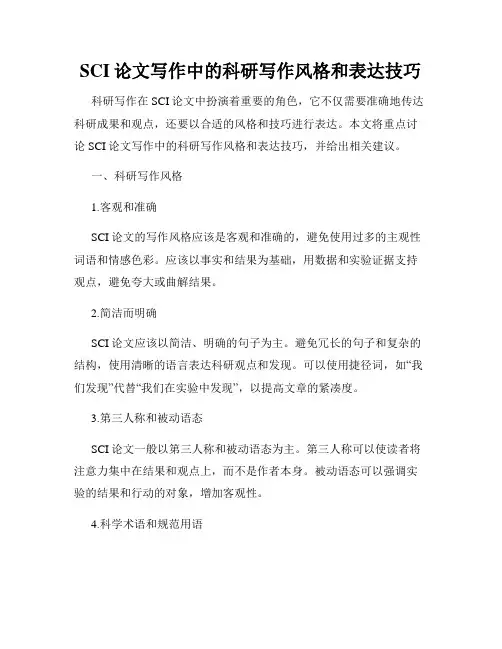
SCI论文写作中的科研写作风格和表达技巧科研写作在SCI论文中扮演着重要的角色,它不仅需要准确地传达科研成果和观点,还要以合适的风格和技巧进行表达。
本文将重点讨论SCI论文写作中的科研写作风格和表达技巧,并给出相关建议。
一、科研写作风格1.客观和准确SCI论文的写作风格应该是客观和准确的,避免使用过多的主观性词语和情感色彩。
应该以事实和结果为基础,用数据和实验证据支持观点,避免夸大或曲解结果。
2.简洁而明确SCI论文应该以简洁、明确的句子为主。
避免冗长的句子和复杂的结构,使用清晰的语言表达科研观点和发现。
可以使用捷径词,如“我们发现”代替“我们在实验中发现”,以提高文章的紧凑度。
3.第三人称和被动语态SCI论文一般以第三人称和被动语态为主。
第三人称可以使读者将注意力集中在结果和观点上,而不是作者本身。
被动语态可以强调实验的结果和行动的对象,增加客观性。
4.科学术语和规范用语SCI论文需要使用科学术语和规范用语,以确保与学界的交流和沟通。
使用行业内广泛接受的术语和规范用语,可以保证文中表达的准确性和可信度。
二、表达技巧1.逻辑结构和段落划分SCI论文应该有清晰的逻辑结构和合理的段落划分。
文章开头应该引出主题,确立研究背景和研究目的;中间部分应该详细叙述实验设计、材料和方法以及实验结果;结尾部分应该总结主要发现,并引申出进一步研究的方向。
2.图表和图片的使用适当使用图表和图片可以更好地展示研究结果和数据。
图表和图片应该清晰易懂,图表的标题和标签应该准确描述其中的内容。
在文中引用图表和图片时,应该使用明确的词语进行解释,不依赖于图表或图片本身,以确保读者可以理解文中的观点和论证。
3.参考文献的引用和注释SCI论文要求对参考文献进行准确的引用和注释。
引用参考文献时,应该使用标准的引用格式,并遵循SCI论文写作的规范。
在文中对参考文献的注释中,可以简要解释该文献的重要性和与本研究的联系。
4.修订和润色SCI论文的写作过程中,需要不断进行修订和润色。

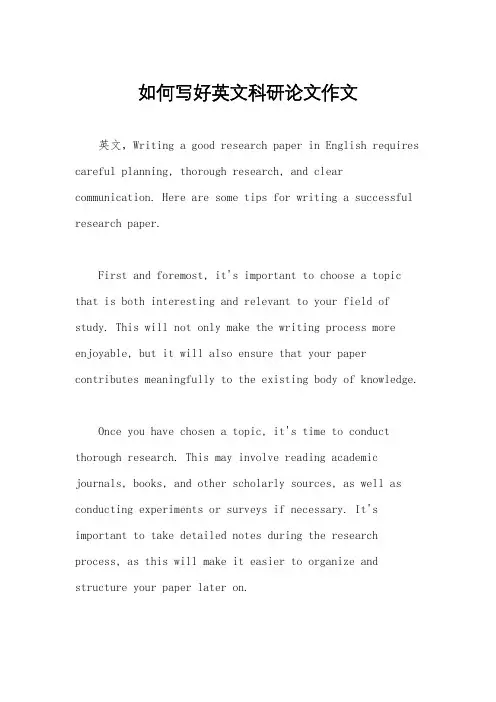
如何写好英文科研论文作文英文,Writing a good research paper in English requires careful planning, thorough research, and clear communication. Here are some tips for writing a successful research paper.First and foremost, it's important to choose a topic that is both interesting and relevant to your field of study. This will not only make the writing process more enjoyable, but it will also ensure that your paper contributes meaningfully to the existing body of knowledge.Once you have chosen a topic, it's time to conduct thorough research. This may involve reading academic journals, books, and other scholarly sources, as well as conducting experiments or surveys if necessary. It's important to take detailed notes during the research process, as this will make it easier to organize and structure your paper later on.When it comes to actually writing the paper, it's crucial to maintain a clear and logical structure. This typically involves an introduction, literature review, methodology, results, discussion, and conclusion. Each section should flow smoothly into the next, and all arguments and claims should be supported by evidence.In addition to a strong structure, it's important to pay attention to the language and style of your writing. This means using clear and concise language, avoiding jargon or overly technical terms, and ensuring that your paper is free from grammatical and spelling errors.Finally, it's essential to properly cite all sources used in your paper. This not only gives credit to the original authors, but it also helps to strengthen the credibility of your own work.In conclusion, writing a good research paper in English requires careful planning, thorough research, clear communication, and attention to detail. By following these tips, you can increase the likelihood of producing asuccessful and impactful research paper.中文,写好一篇英文科研论文需要仔细的规划、深入的研究和清晰的表达。
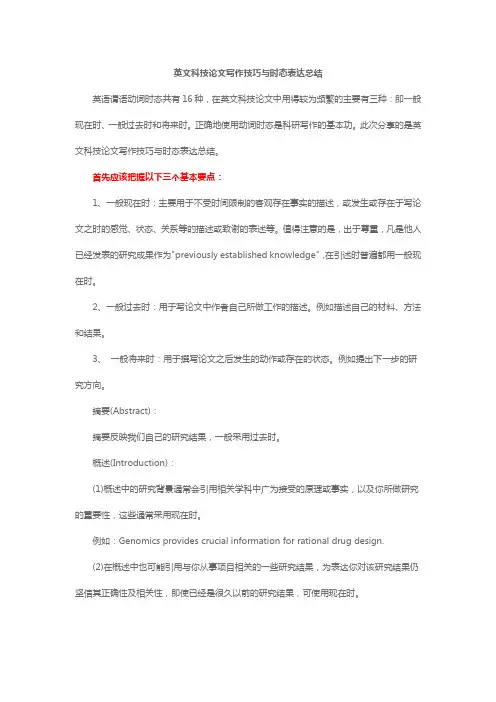
英文科技论文写作技巧与时态表达总结英语谓语动词时态共有16种,在英文科技论文中用得较为频繁的主要有三种:即一般现在时、一般过去时和将来时。
正确地使用动词时态是科研写作的基本功。
此次分享的是英文科技论文写作技巧与时态表达总结。
首先应该把握以下三个基本要点:1、一般现在时:主要用于不受时间限制的客观存在事实的描述,或发生或存在于写论文之时的感觉、状态、关系等的描述或致谢的表述等。
值得注意的是,出于尊重,凡是他人已经发表的研究成果作为"previously established knowledge",在引述时普遍都用一般现在时。
2、一般过去时:用于写论文中作者自己所做工作的描述。
例如描述自己的材料、方法和结果。
3、一般将来时:用于撰写论文之后发生的动作或存在的状态。
例如提出下一步的研究方向。
摘要(Abstract):摘要反映我们自己的研究结果,一般采用过去时。
概述(Introduction):(1)概述中的研究背景通常会引用相关学科中广为接受的原理或事实,以及你所做研究的重要性,这些通常采用现在时。
例如:Genomics provides crucial information for rational drug design.(2)在概述中也可能引用与你从事项目相关的一些研究结果,为表达你对该研究结果仍坚信其正确性及相关性,即使已经是很久以前的研究结果,可使用现在时。
例如:Many of the lakes and wetlands in the region are located in craters or valleys blocked by early Pliocene lava flows (Ollier & Joyce, 1964).Garcia (1993) suggested that under certain conditions, an individual’s deposit income is the same as the income from purchased national debt, thus changes in the amount of bank loans and deposits caused by changes in the amount of reserves will eventually affect the bond price.需要注意的是如果引用的是一些已经过时或失效的科研结果,动词要使用过去时。
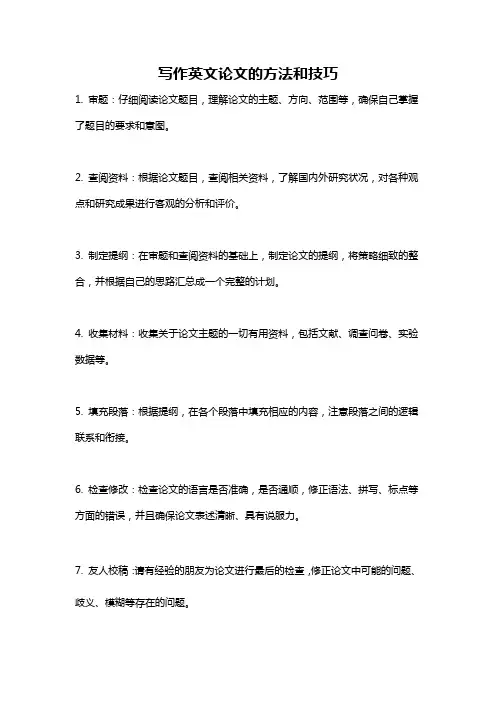
写作英文论文的方法和技巧
1. 审题:仔细阅读论文题目,理解论文的主题、方向、范围等,确保自己掌握了题目的要求和意图。
2. 查阅资料:根据论文题目,查阅相关资料,了解国内外研究状况,对各种观点和研究成果进行客观的分析和评价。
3. 制定提纲:在审题和查阅资料的基础上,制定论文的提纲,将策略细致的整合,并根据自己的思路汇总成一个完整的计划。
4. 收集材料:收集关于论文主题的一切有用资料,包括文献、调查问卷、实验数据等。
5. 填充段落:根据提纲,在各个段落中填充相应的内容,注意段落之间的逻辑联系和衔接。
6. 检查修改:检查论文的语言是否准确,是否通顺,修正语法、拼写、标点等方面的错误,并且确保论文表述清晰、具有说服力。
7. 友人校稿:请有经验的朋友为论文进行最后的检查,修正论文中可能的问题、歧义、模糊等存在的问题。
论文中的英文写作技巧与表达方式在英文学术论文的写作过程中,准确和流畅的表达是非常重要的。
本文将探讨一些论文中的英文写作技巧及表达方式,帮助读者提升论文写作的能力。
1. 写作结构论文的结构对于阐明观点、组织思路至关重要。
以下是一般英文学术论文的常见结构:(1)引言:介绍论文的主题,概述论文的目的和重要性,并提供背景知识。
(2)文献综述:回顾相关的学术研究和理论,评估前人的研究成果。
(3)方法论:描述研究方法、实验设计和数据分析方法。
(4)结果:对实验结果进行客观的描述和分析。
(5)讨论:解释和解读结果,并与前人的研究进行比较和讨论。
(6)结论:总结研究成果,强调重要性和可能的进一步研究方向。
2. 语法和拼写良好的语法和拼写是论文写作的基础。
以下是一些常见的语法和拼写错误,需要注意避免:(1)主谓一致:主语和谓语动词在人称和单复数上要保持一致。
(2)时态一致:使用正确的时态表达,如过去时、现在时或将来时等。
(3)冠词使用:正确使用冠词(a、an、the),并避免过度使用。
(4)拼写错误:仔细校对论文中的拼写错误,可以使用拼写检查工具进行辅助。
3. 学术词汇在写作过程中,合适的学术词汇能够提升论文的专业程度,但过度使用学术词汇反而会让读者难以理解。
以下是一些建议:(1)避免使用口语化的表达方式,如俚语或缩写。
(2)使用学术词汇丰富论文内容,但确保这些词汇确实适用于所描述的概念。
(3)使用词汇表达准确的思想和观点,同时避免以讹传讹,对所使用词汇的准确性要有严谨要求。
4. 表达清晰在论文写作中,清晰的表达是非常重要的。
以下是一些建议:(1)使用简洁的句子结构和控制篇幅,避免过长的句子或段落。
(2)使用逻辑的连接词,如"however"、"therefore"、"in addition"等,帮助读者理解论文的逻辑。
(3)对于复杂的概念,使用图表或实例来解释,以帮助读者更好地理解。
英语学术文章写作技巧
学术文章写作是一种重要的学术交流方式,对于学术研究和学术发展
具有重要的作用。
然而,对于许多人而言,学术文章写作可能是一项挑战。
下面是一些关于如何写作有效的英语学术文章的技巧。
1.确定目标读者:在开始写作之前,确定您的目标读者是谁。
这将有
助于你决定使用什么样的语言和内容。
根据目标读者的背景和知识水平,
选择适当的术语和信息。
2.清晰明确的表达观点:确保你的观点清晰明确,并在文章中进行适
当的展示和解释。
使用简洁明了的语言和句子来清晰地表达你的观点,避
免使用模糊或含糊不清的词语。
3.结构化组织文章:为你的文章制定一个明确的结构,并确保你的观
点有逻辑地展开。
有一个明确的引言,包括一个清晰的论述陈述,并确保
每个段落都有一个明确的主题。
使用适当的过渡词语,使得文章的结构更
加流畅。
5.避免使用不必要的复杂语言:尽量避免使用过于复杂的语言和术语,除非你确定你的目标读者具备相应的背景知识。
选择简单明了的语言和句子,以便更容易理解和理解你的论点。
6.基于先前研究:在你的学术文章中,参考和引用相关的先前研究,
以展示你的研究在学术领域中的位置。
这不仅可以增加你的文章的可信度,还可以引起学术界的关注和兴趣。
8.经常练习写作:写作是一项需要不断练习的技巧。
通过经常写作,
你将发展你的写作技巧,并变得更加精通。
尝试写作不同类型的文章,包
括研究论文、评论和综述,以帮助你提高你的写作能力。
只要发英文文章,就要遵循规则,不会写或者写不好不是抄的理由。
在英美体系中,作者写的东西属于创作,是不能剽窃的。
除非只想混文凭而已。
若搞科研,不从最初提高自己,遵循科研的规则,则百害无益。
一些常见的英文文章语言技巧1如何指出当前研究的不足以及有目的地引导出自己的研究的重要性通常在叙述了前人成果之后,用However来引导不足,比如:However, little information..little attention...little work...little datalittle researchor few studiesfew investigations...few researchers...few attempts...or nonone of these studieshas (have) been lessdone on ...focused onattempted toconductedinvestigatedstudied(with respect to)Previous research (studies, records) has (have)failed to considerignoredmisinterpretedneglected tooverestimated, underestimatedmisleadedthus, these previus results areinconclisive, misleading, unsatisfactory, questionable, controversial..Uncertainties (discrepancies) still exist ...这种引导之后一般会提出一种新方法,或者一种新方向。
如果研究的方法以及方向和前人一样,可以通过下面的方式强调自己工作的作用:However, data is still scarcerareless accuratethere is still dearth ofWe need toaim tohave toprovide more documentsdatarecordsstudiesincrease the datasetFurther studies are still necessary...essential...为了强调自己研究内容的重要性,一般还要在However之前介绍自己研究问题的反方面,另一方面等等。
写英文论文的几个小技巧(精选5篇)第一篇:写英文论文的几个小技巧小弟不才,迄今才撰写了三篇英文文章,但写作过程中也积累了一点经验,不敢敝帚自珍,今天也斗胆向各位虫友贡献一下。
我这几篇文章,不论内容如何,但每次审稿人对于语言的评价都是还不错的,well written,总结起来不外有三个小窍门:一是平时多积累。
我在日常读文献的时候,如果发现很好的句子句式,都会记录在一个文档里面,如下面的一段话,就是我在一篇文章的摘要中发现的:This paper describes the concept of sensor networks which has been made viable by the convergence of microelectro-mechanical systems technology, wireless communications and digital electronics.First, the sensing tasks and the potential sensor networks applications are explored, and a review of factors influencing the design of sensor networks is provided.Then, the communication architecture for sensor networks is outlined, and the algorithms and protocols developed for each layer in the literature are explored.Open research issues for the realization of sensor networks are also discussed.文章用词忌重复,中文如此,英文亦然。
英文学术论文写作与发表技巧Academic writing and publishing are vital skills for those who want to excel in the fields of education, research, and professional discourse. Writing an academic paper involves a complex process of research, analysis, formatting, and editing, whereas publishing requires understanding the intricacies of manuscript preparation, submission, and peer-review. This article aims to provide an overview of the key techniques for academic writing and publishing, starting from selecting a topic, organizing the paper, citation and referencing, formatting, and submitting the manuscript for publication.1. Selecting a topicThe first step in writing an academic paper is to identify and narrow down a topic. The topic should be specific, precise, and relevant to the discipline or field of study. A good starting point is to review the literature, identify gaps or areas of interest, and formulate research questions that can be answered through empirical evidence. The topic should also be feasible in terms of time, scope, and resources available for conducting a study.2. Organizing the paperOnce the topic has been selected, the next step is to organize the paper into sections, beginning with an introduction that provides context and background information on the topic, followed by a literature review that outlines previous studies and research gaps. The methodology section should describe the research design, sample size, data collection methods, and statistical analysisprocedures.The results section should present the findings in an objective and clear manner, whereas the discussion section should interpret the results, discuss their implications, and suggest future research directions. Finally, the conclusion should summarize the key findings, restate the research questions, and draw overarching conclusions.3. Citation and referencingCitation and referencing are essential for academic writing because they provide evidence of the sources that have been used in the research, indicate the credibility of the study, and enable readers to locate and access the cited sources. The citation style should be consistent throughout the paper, and conform to the guidelines of the particular discipline or journal.4. FormattingFormatting involves the presentation of the paper in a professional and readable format, including the use of headings, fonts, margins, and spacing. The paper should also conform to the guidelines of the particular journal or publisher, including the preferred referencing style, manuscript length, and format. Attention to detail in formatting can increase the chances of acceptance for publication.5. Submitting the manuscript for publicationOnce the manuscript has been completed, it should be reviewed for grammatical errors, clarity, coherence, and overall quality before submitting it for publication. The submission process involves selecting an appropriate journal or publisher, following the guidelines for manuscript preparation, and submitting the paper online or through email. The review process involves evaluation by the editorial board or peer-reviewers, who provide feedback on the quality, relevance, and contribution of the study. Based on the feedback, authors can revise and resubmit the manuscript, or withdraw it and submit it to another journal or publisher.In conclusion, academic writing and publishing require a systematic and disciplined approach that involves selecting a suitable topic, organizing the paper, citing and referencing sources, formatting, and submitting it for publication. With practice, patience, and attention to detail, authors can improve their writing and publishing skills, and contribute to the advancement of knowledge in their respective fields.6. Tips for effective academic writing- Start with a clear and concise thesis statement that summarizes the main argument or research question, and guides the structure of the paper.- Use plain language and avoid technical jargon, unless it is necessary for clarity and precision.- Write in an objective and impersonal tone, avoiding personal opinions or emotions that may bias the interpretation of the data. - Use active voice and vary sentence structures to maintain reader engagement and clarity.- Follow the guidelines of the particular discipline or journal forcitation and referencing, which may include using footnotes, endnotes, or in-text citations.- Revise and proofread the paper multiple times, checking for grammar, spelling, punctuation, and formatting errors.- Seek feedback from colleagues, mentors, or writing tutors who can provide constructive criticism and suggestions for improvement.7. Tips for publishing academic papers- Select a journal or publisher that is reputable, relevant to the topic, and aligned with the research goals and scope.- Follow the guidelines for manuscript preparation and submission, which may include instructions for formatting, word count, file format, cover letter, and author declaration.- Choose appropriate keywords, abstract, and title that capture the essence of the study and attract readers' attention.- Engage in peer-review, which involves evaluating other scholars' papers and providing constructive feedback that can improve the quality and relevance of the research.- Stay up-to-date with the latest trends, debates, and theoretical frameworks in the field, by attending conferences, reading journals, and networking with peers.- Take advantage of social media, blogs, and online platforms to disseminate the findings and insights of the research to wider audiences, including policymakers, practitioners, and the general public.8. Challenges and opportunities in academic writing and publishingAcademic writing and publishing can be a rewarding but also challenging endeavour, as it requires dedication, perseverance, and continuous learning. Some of the challenges that scholars face include:- Time management, as writing and publishing can be time-consuming and require balancing multiple tasks and priorities.- Rejection and criticism, as not all papers get accepted for publication, and the feedback from reviewers can be rigorous and demanding.- Ethical considerations, such as plagiarism, data fabrication, and conflicts of interest, which can undermine the credibility and integrity of the research and authorship.However, there are also opportunities for growth, innovation, and impact in academic writing and publishing, such as:- Collaboration and teamwork, as scholars can benefit from exchanging ideas, collaborating on research projects, and co-authoring papers that showcase diverse perspectives and expertise. - Interdisciplinary and cross-cutting approaches, as academic writing and publishing can bridge different fields, methods, and theories, and contribute to solving complex and pressing social, economic, and environmental issues.- Open access and public engagement, as academic writing and publishing can involve making research findings and insights available to wider audiences, including policymakers, practitioners, and citizens, who can use them to inform their decisions and actions.In conclusion, academic writing and publishing are essential skills for scholars who aim to contribute to the advancement of knowledge in their fields, and communicate their ideas and insights to wider audiences. By following the key techniques and tips outlined in this article, scholars can improve their writing and publishing skills, overcome the challenges, and seize the opportunities of academic scholarship.。
英文SCI论文写作时的引用格式技巧SCI期刊是国际上享有较高学术声誉的期刊,对于想要发表英文SCI论文的研究人员来说,正确的引用格式十分重要。
本文将介绍几个在SCI论文写作中常用的引用格式技巧。
1. 引用格式规范在SCI论文中,引用格式应符合特定的规范,比如APA格式或者MLA格式。
在论文中,可以使用脚注或者直接在文中引用来标注引用的来源。
2. 引用书籍对于引用书籍,可以按照以下格式进行引用:- 书籍的作者、出版年份和书名应该明确列出。
- 引用书籍时,应该包括章节的名称和页码,以便读者可以找到具体的引用内容。
- 在文中引用书籍时,可以使用作者和出版年份的方式,例如:"根据Johns (2010)的研究结果,..."。
3. 引用期刊文章对于引用期刊文章,可以按照以下格式进行引用:- 引用期刊文章时,应该包括作者、文章标题、期刊名称、发布年份、卷号和页码。
- 在文中引用期刊文章时,可以使用作者和出版年份的方式,例如:"在Smith等人的研究中 (2015),..."。
4. 引用网页资源对于引用网页资源,可以按照以下格式进行引用:- 引用网页资源时,应包括作者(如果有)、标题、网页名称、发布年份、URL和访问日期。
- 在文中引用网页资源时,可以使用作者和出版年份的方式,例如:"根据Google的统计数据 (Google, 2020),..."。
5. 引用会议论文对于引用会议论文,可以按照以下格式进行引用:- 引用会议论文时,应包括作者、文章标题、会议名称、发布年份、页码和发布地点。
- 在文中引用会议论文时,可以使用作者和出版年份的方式,例如:"在Jones等人的论文中 (2008),..."。
6. 引用他人观点在引用他人观点时,应该明确注明出处,并使用引号或者斜体来标识引用内容。
同时,还应提供该观点的作者和出版年份。
以上是英文SCI论文写作时的引用格式技巧。
英文科研论文写作简介1. 引言英文论文写作的前提是有创新研究成果,创新研究成果的关键是选题。
“An acceptable primary scientific publication” must be “the first disclosure”.科研论文写作常出现的一个误区是:以为好论文是“写”出来的,只要会写,论文总能被接受发表。
其实,论文被发表只是结果,这个结果是和一系列科研环节密切相关的,论文写作只是其最后一个环节。
在选择科研课题和工作切入点时,就需特别注意,一定要有创新内容,科学研究的灵魂是创新,重复别人的工作,从科研的角度来说,是没有意义的。
值得注意的是,阅读有关英文科技论文,不仅可以了解研究进展和动态,而且,可以学会科技英文表达。
同样,选题很好,研究工作做得不够细致、深入,也难有说服力,难以成为有价值的研究工作。
由于本书只介绍英文科研论文的写作,不讲如何做研究,因此只介绍有了好的研究成果后如何写成合格的科研文章。
The goal of scientific research is publication. Scientists, starting as graduate students, are measured primarily not by their dexterity in laboratory manipulations, not by their innate knowledge of either broad or narrow scientific subjects, and certainly not by their wit or charm; they are measured, and become known (or remain unknown) by their publications.A scientific experiment, no matter how spectacular the results, is not completed until the results are published.Thus, the scientists must not only “do” the science but must “write” science. Bad writing can and often does prevent or delay the publication of good science.2.科研论文的一般格式。
科研论文,不象散文、小说那样形式可以千姿百态,而具有较为固定的格式。
从某种意义上说,科研论文是“八股文”。
The IMRAD format.What question (problem) was studied? The answer is the Introduction. How was the problem studied? The answer is the Methods. What were the findings? The answer is the Results. What do these findings mean? The answer is the Discussion.其通常的组成和每部分的特点见表1。
表1 科研论文格式及其特点以上为英文科技论文的一般要求,不同期刊风格和要求会有所不同。
练习1。
2. 科技论文的写作步骤步骤及注意事项如同绘画。
绘画要构思、画轮廓、再描绘、收拾。
科技论文的写作步骤见表2。
表2 英文科技论文写作步骤值得注意的是,论文最好在研究工作进行中就开始酝酿,这样对研究本身的完整性会有帮助,而且,写作过程中也往往会发现一些问题,由于实验装置尚在,实验还可进行,这些问题还可方便解决。
练习2。
3.各部分写作的注意事项3.0 如何写论文题目First impressions are strong impressions; a title ought therefore to be well studied, and to give, so far as its limit permit, a definite and concise indication of what is to come.----T. Cliffort AllburtWhat is good title? I define it as the fewest possible words that adequately describe the context of the paper.3.1 如何写英文摘要英文摘要是全文的浓缩,一般包括研究目的、研究方法、研究结果和结论。
摘要是全文的摘要,因此论文从引言(Introduction)、论文展开(Approach),结果(Results)和讨论(Discussion)以及结论部分的要点在引言中都应有反映。
摘要部分应尽可能简明,一般不超过300个词,摘要比论文具有更广泛的读者,因此,尽量用通俗和易懂的词汇(这些词汇无需通过阅读全文或查相关文献后就可明白),且风格、时态等应统一。
在英文摘要中,时态可以是一般现在时,一般过去时和现在完成时,具体用何种时态,应根据表达的内容而定,但一般多用被动语态。
请看下面的例1-例7。
注意,摘要中别忘了写出论文的主要发现或结论。
一般情况下,摘要中不列参考文献,不含图表。
英文摘要内容完整,可独立存在。
摘要虽在最前面,但实际上,它往往最后写。
等全文完成后,再根据全文的内容提炼和推敲。
当然,有些国际会议,开始只需要提交摘要,这时,摘要常常先写。
下面列举了几篇国际期刊论文的英文摘要,供读者参考。
同时注意缩写字的使用。
摘要例1[1]Abstract:Interactions between volatile organic compounds (VOCs) and vinyl flooring (VF), a relatively homogenous, diffusion-controlled building material, were characterized. The sorption/desorption behavior of VF was investigated using single-component and binary systems of seven common VOCs ranging in molecular weight from n-butanol to n-pentadecane. The simultaneous sorption of VOCs and water vapor by VF was also investigated. Rapid determination of the material/air partition coefficient (K) and the material-phase diffusion coefficient (D) for each VOC was achieved by placing thin VF slabs in a dynamic microbalance and subjecting them to controlled sorption/desorption cycles. K and D are shown to be independent of concentration for all of the VOCs and water vapor. For the four alkane VOCs studied, K correlates well with vapor pressure and D correlates well with molecular weight, providing a means to estimate these parameters for other alkane VOCs. While the simultaneous sorption of a binary mixture of VOCs is non-competitive, the presence of water vapor increases the uptake of VOCs by VF. This approach can be applied to other diffusion-controlled materials and should facilitate the prediction of their source/sink behavior using physically-based models.Keywords: Building material; Emission; Indoor air; Microbalance; Sink; Sorption摘要例2[2]Abstract: Desiccant systems have been proposed as energy saving alternatives to vapor compression air conditioning for handling the latent load. Use of liquid desiccants offers several design and performance advantages over solid desiccants, especially when solar energy is used for regeneration. For liquid-gas contact, packed towers with low pressure drop provide good heat and mass transfer characteristics for compact designs. This paper presents the results from a study of the performance of a packed tower absorber and regenerator for an aqueous lithium chloride desiccant dehumidification system. The rates of dehumidification and regeneration, as well as the effectiveness of the dehumidification and regeneration processes were assessed under the effects of variables such as air and desiccant flow rates, air temperature and humidity, and desiccant temperature and concentration. A variation of the Öberg and Goswami Mathematical model was used to predict the experimental findings giving satisfactory results.摘要例3[3]Abstract: This paper presents a performance evaluation of two passive cooling strategies, daytime ventilation and night cooling, for a generic, six-story suburban apartment building in Beijing and Shanghai. The investigation uses a coupled, transient simulation approach to model heat transfer and airflow in the apartments. Wind-driven ventilation is simulated using computational fluid dynamics (CFD). Occupant thermal comfort is accessed using Fanger’s comfort model. The results show that night cooling is superior to daytime ventilation. Night cooling may replace air-conditioning systems for a significant part of the cooling season in Beijing, but with a high condensation risk. For Shanghai, neither of the two passive cooling strategies can be considered successful.摘要例4[4]ABSTRACT: This paper presents the results of a computer program developed for solving 2- and 3-D ventilation problems. The program solves, in finite difference form, the steady-state conservation equations of mass, momentum and thermal energy. Presentation of the fluctuating velocity components is made using the k-εturbulence model. Predicted results of air velocity and temperature distribution in a room are corroborated by experimental measurements. The numerical solution is extended to other room ventilation problems of practical interest.3.2 如何写引言中国有句俗话:好的开头等于成功的一半。